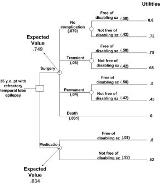A DECISION ANALYSIS OF TEMPORAL LOBECTOMY AS COMPARED WITH CONTINUED MEDICAL MANAGEMENT FOR REFRACTORY TEMPORAL LOBE EPILEPSY
Abstract number :
2.433
Submission category :
Year :
2005
Submission ID :
5740
Source :
www.aesnet.org
Presentation date :
12/3/2005 12:00:00 AM
Published date :
Dec 2, 2005, 06:00 AM
Authors :
1Hyunmi Choi, 2Randall Sell, and 1Frank G. Gilliam
Current clinical practice parameter recommends epilepsy surgery for patients with refractory temporal lobe epilepsy on chronic medical therapy. However, epilepsy surgery is underutilized in these patients. Decision analysis is a quantitative method that can be used to help clinicians and patients make optimal decisions. Here we developed two decision analysis models in order to estimate the expected utility and the expected life expectancy associated with temporal lobectomy versus continued medical management. We used decision analysis to combine published estimates of the probabilities for various events of treatment with the patient[apos]s values for these events (i.e. utility). We also combined these published estimates with our estimates of life expectancy. Using data from the table of vital statistics for a hypothetical person of 35 years of age, and an estimate of excess mortality due to epilepsy, we used the DEALE method to calculate life expectancy.
We analyzed our models by a process of folding back and averaging. Data were analyzed with the Excel program Based on our review of the published literature, we found the following estimates(Table 1).
We found that the expected utility after surgery was 0.749 compared to that of 0.634 after continued medical management, implying a net benefit of 0.115 (Figure 1). That is, patients after surgery are likely to experience an 18% [(0.115/0.634) *100] increase in overall value of life relative to persons on continued medical management.
We found that on average, a 35 year-old patient gains 3.7 years of life expectancy from epilepsy surgery compared to 0.5 year from continued medical management.
We found that the expected utility values were not sensitive to assumptions about the probabilities of various events. Although further research is necessary, our current decision analysis models demonstrate that temporal lobectomy maximizes the expected utility by 18% and the life expectancy by 3.2 years compared to continued medical management. Our finding of gain in life expectancy after temporal lobectomy compares favorably to other surgical procedures such as 3-vessel CABG (gain of 4-14 months).[table1][figure1]
